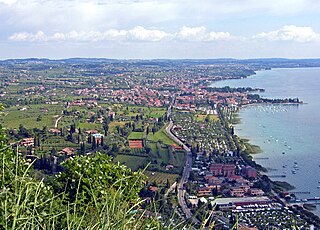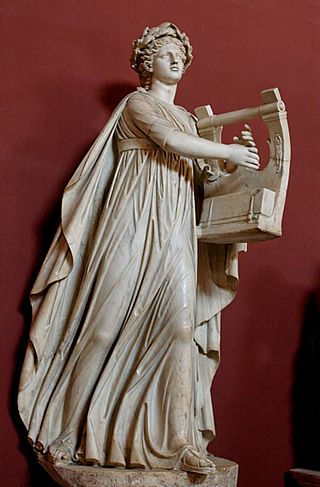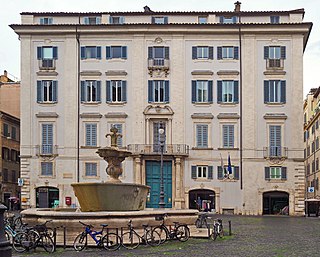
The House of Orsini is an Italian noble family that was one of the most influential princely families in medieval Italy and Renaissance Rome. Members of the Orsini family include five popes: Stephen II (752–757), Paul I (757–767), Celestine III (1191–1198), Nicholas III (1277–1280), and Benedict XIII (1724–1730). In addition, the family included 34 cardinals, numerous condottieri, and other significant political and religious figures.

The Quirinal Hill is one of the Seven Hills of Rome, at the north-east of the city center. It is the location of the official residence of the Italian head of state, who resides in the Quirinal Palace; by metonymy "the Quirinal" has come to stand for the Italian president. The Quirinal Palace has an extension of 1.2 million square feet.

Scopas was an ancient Greek sculptor and architect, most famous for his statue of Meleager, the copper statue of Aphrodite, and the head of goddess Hygieia, daughter of Asclepius.

The Province of L'Aquila is the largest, most mountainous and least densely populated province of the Abruzzo region of Central Italy. It comprises about half the landmass of Abruzzo and occupies the western part of the region. It has borders with the provinces of Teramo to the north, Pescara and Chieti to the east, Isernia to the south and Frosinone, Rome and Rieti to the west. Its capital is the city of L'Aquila.

The Theatre of Pompey was a structure in Ancient Rome built during the latter part of the Roman Republican era by Pompey the Great. Completed in 55 BC, it was the first permanent theatre to be built in Rome. Its ruins are located at Largo di Torre Argentina.

Garda is a town and comune on the shore of Lake Garda, in the province of Verona, Veneto, northeastern Italy.

Piazza della Signoria is a w-shaped square in front of the Palazzo Vecchio in Florence, Italy. It was named after the Palazzo della Signoria, also called Palazzo Vecchio. It is the main point of the origin and history of the Florentine Republic and still maintains its reputation as the political focus of the city. It is the meeting place of Florentines as well as the numerous tourists, located near Palazzo Vecchio and Piazza del Duomo and gateway to Uffizi Gallery.

The Loggia dei Lanzi, also called the Loggia della Signoria, is a building on a corner of the Piazza della Signoria in Florence, Italy, adjoining the Uffizi Gallery. It consists of wide arches open to the street. The arches rest on clustered pilasters with Corinthian capitals. The wide arches appealed so much to the Florentines that Michelangelo proposed that they should be continued all around the Piazza della Signoria.

Parione is the 6th rione of Rome, identified by the initials R. VI, and belongs to the Municipio I. Its name comes from the fact that in the area there was a huge ancient wall, maybe belonging to the stadium of Domitianus; the nickname people gave to this wall was Parietone, from which the name Parione.

The Minor Basilica of St. Lawrence in Damaso or simply San Lorenzo in Damaso is a parish and titular church in central Rome, Italy that is dedicated to St. Lawrence, deacon and martyr. It is incorporated into the Palazzo della Cancelleria, which enjoys the extraterritoriality of the Holy See.
The Università degli studi Internazionali di Roma is a private state-recognised university located in Rome, Italy.

An Apollo Citharoedus, or Apollo Citharede, is a statue or other image of Apollo with a cithara (lyre). Among the best-known examples is the Apollo Citharoedus of the Vatican Museums, a 2nd-century AD colossal marble statue by an unknown sculptor. Apollo is shown crowned with laurel and wearing the long, flowing robe of the Ionic bard. The statue was found in 1774, with seven statues of the Muses, in the ruins of Gaius Cassius Longinus' villa near Tivoli, Italy. The sculptures are preserved in the Hall of the Muses, in the Museo Pio-Clementino of the Vatican Museums.

Hercules of the Forum Boarium is one of two gilded bronze statues of Hercules found on the site of the Forum Boarium of ancient Rome. The two statues were both placed in the Palazzo Dei Convervatori for safe keeping in 1950 and remain there today. The Hercules of Forum Boarium was likely to have been a cult image of Temple of Hercules that stood by the ancient cattle market.
Righetti is an Italian language surname. Notable people with the surname include:
Palazzo Pio can refer to:

The Palazzo Orsini is a neoclassic-style palace located on via Borgonuovo #11 in Milan, region of Lombardy, Italy.

Claudio Kevo Cavallini was an Italian sculptor. His nickname was "Kevo" with which he signed his works. At the age of 50, Claudio discovered that he could make sculptural forms from wood.

The Palazzo Fusconi-Pighini is a Renaissance-style palace located on Piazza Farnese #44 in the rione Regola of central Rome, Italy.

Simone Moschino was an Italian Renaissance sculptor and architect, born in Orvieto as Simone Simoncelli.

















